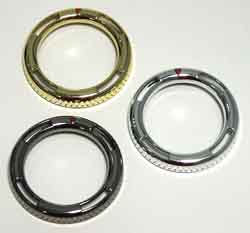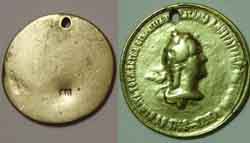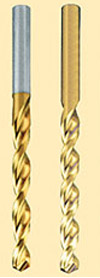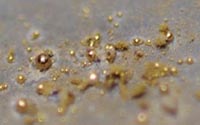Alloys of gold

If we consider the precious metal in a completely pure form (or very close to pure without impurities), it is soft and malleable metal.Therefore, in order to preserve its beauty (to avoid scratches and small damages on its surface), very widely used alloys of gold with other metals. The most common are alloys of copper and silver, at least - with platinum and palladium, more rarely with steel and cadmium.
Alloys of gold antimony, lead ,bismuth, tin and zinc is not used for jewelry, as they are very fragile,and therefore cannot be processed by percussion method or in rolls. If it alloying with silver and copper is well rolled and forged. Under this treatment the alloy is very hard, which in turn requires hardening. lloys with steel, platinum and palladium are used rarely. This is due to their great hardness and refractoriness. But its leads to difficulties in their machining. Alloys with cadmium quite fusible, but because of their fragility are rarely used. The presence of metals in the gold alloy called ligature.
Stamp of gold
.How is the stamp of gold determined

Stamp of gold determines the quality of the alloy and the weight content of pure metal on each thousandth part of alloy. If they say that stamp of gold is 583, each a thousand parts alloy consists of 583 parts of pure metal and 417 parts of the ligature, that is, (583+417=1000).
Stamp of gold is also determined by using the assay stone with polished matte surface. Product is scratched on it and left a trace is compared with the color of the strokes from the reference metal alloys known stamps.
To approximate the stamp is also used chemical method: the scratch on the touchstone treated with special solutions. Concentrated 72% nitric acid completely dissolves trail from the gold alloy is less than 333 stamp. If the strok is colored in brown, the sample is from 333 to 500, and if no change is above 500. Brown trail is gold remaining after dissolution of other metals (copper, silver) in it alloy. Using a mixture of nitric and hydrochloric acid you can determine the approximate content of precious metal alloys with a stamps from 160 to 1000 for a few minutes.
Color of gold

We've learned that the precious metal always has a yellow color, at least, product with it color can often be found in jewelry stores. But if someone says that gold can be, for example blue, it is hard to believe! (if they believe). Yes, indeed, this precious metal has a sufficient variety of colour shades, not less beautiful than his natural and familiar yellow color. It is widely used in modern design together with precious stones.
The color of this metal also depends on the quality of ligatures. The more copper contains ligature, the alloy more red; silver content gives it a pale yellow, cadmium green, steel gives grey, bluish-grey or even blue colour; platinum - white color, palladium - brown color.
So, what is caused the color of this metal?
The name gold Au (Aurum) means "yellow". Color (pure, without impurities) - bright yellow. Copper and silver are the most common impurities.
For example, if you want to get gold with a reddish tint, then you take on weight parts of 58.5 % gold, 32,5% copper and 9% silver.
It is even green (actually pale green), which is obtained by the addition of 41.5% silver.
НBelow are gold alloys and result the color of gold is changed:
- yellow
- 114 parts pure Au, 3 parts of copper, 7 parts of pure silver, or
- 14 (Au) : 4 (copper) : 6 (silver)
- 18 (Au) : 2 + 1/2 (copper) : 3 + 1/2 (silver),
- red
- 14 (Au) : 7 (copper) : 3 (silver)
- 14 (Au) : 8 (copper) : 2 (silver)
- 14 (Au) : 9 (copper) : 1 (silver)
- 14 (Au) : 10 (copper)
- green
- 2 (Au) : 1 (silver)
- 9 (Au) : 2 (silver) : 1 (cadmium)
- 75 (Au) : 11 + 1/2 (silver) : 4 + 1/2 (cadmium) : 9 (copper)
- 75 (Au) : 12 + 1/2 (silver) : 12 + 1/2 (cadmium)
- grey
- 30 (Au) : 2 (steel) : 8 (silver)
- 4 (Au) : 1 (steel)
- blue
- 3 parts of pure Au and 1 part steel or 2 parts pure gold and 1 part steel
- white
- 11 parts of pure Au and 1 part of platinum
- brown
- 18 parts of pure Au, 11 parts of pure silver, 13 parts of copper and 6 parts of palladium
This alloy is very hard and is used for linings under the trunnion axis in the mechanisms of hours.
Faux gold

Drills coated with titanium nitrile look no different from gold Faux gold in color does not differ from the present, but it can be determined with the mass of the item or with simple chemical reactions.
The following are the chemical compositions of artificial gold and its application
Gold leaf
Gold leaf is used for gilding cheap wooden and plaster products, it is sulfide tin(IV) SnS2. This compound is formed in soft shiny Golden scales by heating a metal tin with sulfur.At higher temperatures (> 520 °C) gold leaf dark - decomposes on SnS and sulfur.
Another type of artificial gold can be called titanium gold
Titanium gold
Modern science and technology often require ultra-high vacuum, which cannot create regular mercury pumps. And then rescued titanium, having the ability to form complex substances, firmly communicating with the main components of air. In the camera titanium reacts with oxygen and nitrogen, tying them in oxide TiO2 and the nitride TiNx (where x is from 0.58 to 1.00), which creates ultra-high vacuum.
This property of titanium is used to remove oxygen and nitrogen from steel to improve its quality.But especially promising was the use of thin coatings of titanium nitrile - one of the most robust chemical compounds.Using modern technology (including laser), the substance is applied with a layer thickness of 2 to 3 ?m on the surface, you need to do hard and wear-resistant. Coated with titanium nitride tools (cutters, drills) and last longer, and increase productivity. And they look exactly like gold because the color of titanium nitride almost the same as gold.
Nitride coatings are used widely, for example for dental crowns, gold domes. So, the dome of the Cathedral of Christ the Savior in Moscow almost completely covered with titanium nitride, which is a little more reddish color in comparison with nearby gilded domes of the Kremlin cathedrals.
Interesting facts about gold
- - The country, which produces 67% of all the world's gold reserves of this precious metal is South Africa!
- - The decoration of the teeth (even healthy!) gold crowns were very fashionable and stylish in the late 18th century. Such a luxury afforded only by wealthy people.
- - old is a very malleable metal: dimensions of the ingot in boxes of matches can be made foil dimensions tennis court
- - Gold is quite soft metal: pure metal can deform, rumple by hands

Can living organisms to make their own gold?! It turns out that they can!!!
In one of the American research centers was discovered bacterium, which produces GOLD! (this bacterium - Cupriavidus metallidurans). This bacterium converts a complex chemical compound is a chloride of gold found in nature in the free state in pure gold! The chemical - chloride of gold - toxic substance, but the bacteria are resistant to it!
Naturally, scientists had created a portable laboratory, which retrieves pure gold!